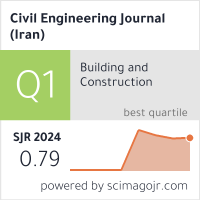Analyzing of Morphometric Parameters and Designing of Thematic Maps Using Raster Geoprocessing Tool
Downloads
Doi: 10.28991/CEJ-2022-08-09-06
Full Text: PDF
Downloads
[2] Clarke, J. I. (1996). Morphometry from maps. Essays in geomorphology. Elsevier Publishing Company, New York, United States.
[3] Agarwal, C. S. (1998). Study of drainage pattern through aerial data in Naugarh area of Varanasi district, U.P. Journal of the Indian Society of Remote Sensing, 26(4), 169–175. doi:10.1007/BF02990795.
[4] Reddy, G. O., Maji, A. K., & Gajbhiye, K. S. (2002). GIS for Morphometric analysis of river basins. GIS India, 11, 9-14.
[5] Water Framework Directive (WFD) 2000/60EC. (2000). "Water Framework Directive, European Parliament and of the Council of 23 October 2000”. Available online: https://ww.eea.eutropa.eu (accessed on May 2022).
[6] Patel, A., Katiyar, S. K., & Prasad, V. (2016). Performances evaluation of different open-source DEM using Differential Global Positioning System (DGPS). Egyptian Journal of Remote Sensing and Space Science, 19(1), 7–16. doi:10.1016/j.ejrs.2015.12.004.
[7] The Independent Commission for Mines and Minerals. (2022). Geological map 1:100 000, 1:200 000, and Hydrogeologycal map off Kosovo 1:200 000, 2006. Prishtiní«, Kosovo.
[8] Labus, D. (1973). Hydrological characteristics of Goles mountain, Contribution to the knowledge of water in the serpentines of Kosovo. Proceedings 1, Prishtina, Kozovo. (in Serbian).
[9] Cadastral Agency of Kosovo. (2022). State Geoportal-Topographic map 1: 25000. Prishtina, Kozovo.
[10] Strahler, A. N. (1957). Quantitative analysis of watershed geomorphology. Eos, Transactions American Geophysical Union, 38(6), 913–920. doi:10.1029/TR038i006p00913.
[11] Aadil Hamid, R. A. H. (2013). Application of Morphometric Analysis for Geo-Hydrological Studies Using Geo-Spatial Technology-A Case Study of Vishav Drainage Basin. Journal of Waste Water Treatment & Analysis, 04(03), 1–12. doi:10.4172/2157-7587.1000157.
[12] Horton, R. E. (1945). Erosional development of streams and their drainage basins; hydrophysical approach to quantitative morphology. Geological Bulletin of the Geological Society of America, 56(3), 275-370. doi:10.1130/0016-7606(1945)56[275: EDOSAT]2.0.CO;2.
[13] Schumm, S. A. (1956). Evolution of drainage systems and slopes in badlands at Perth Amboy, New Jersey. Bulletin of the Geological Society of America, 67(5), 597–646. doi:10.1130/0016-7606(1956)67[597:EODSAS]2.0.CO;2.
[14] IBAL, S. (2009). Environmental Planning and Management Plan for the Las Panelas and La Balsa Ravines Micro-basin. (In Spanish).
[15] Melton, M. A. (1957). An analysis of the relations among elements of climate, surface properties, and geomorphology. Department of Geology, Columbia University, Technical Report, 11, Project NR 389-042. Office of Navy Research, New York, United States.
[16] Gravelius, H. (1914). Fundamentals of the entire Gewcisserkunde. Volume I: Flufikunde. Compendium of Hydrology I. Rivers. (In German).
[17] Horton, R. E. (1932). Drainage-basin characteristics. Transactions, American geophysical union, 13(1), 350-361.
[18] Perez. J. (1979). Fundamentals of the Hydrological Cycle. Universidad Central de Venezuela.”, Faculty of Engineering Department of Meteorology and Hydrology, Caracas, Venezuela. (In Spanish).
[19] Miller, V. C. (1953). A Quantitative Geomorphic Study of Drainage Basin Characteristics in the Clinch Mountain Area Virginia and Tennessee. Department of Geology Columbia University, New York, United States.
[20] Withanage, N. S., Dayawansa, N. D. K., & De Silva, R. P. (2015). Morphometric analysis of the Gal Oya river basin using spatial data derived from GIS. Tropical Agricultural Research, 26(1), 175. doi:10.4038/tar.v26i1.8082.
[21] Yanxia, S., Qi, Z., & Chunbo, J. (2022). A dynamic bidirectional coupling model for watershed water environment simulation based on the multi-grid technique. Science of the Total Environment, 843, 156760. doi:10.1016/j.scitotenv.2022.156760.
[22] Verma, S., Khalkho, D., & Gupta, L. K. (2020). Morphometric Analysis of a Drainage Basin using Remote Sensing and Geographical Information System (GIS). International Journal of Current Microbiology and Applied Sciences, 9(4), 1950–1959. doi:10.20546/ijcmas.2020.904.232.
- Authors retain all copyrights. It is noticeable that authors will not be forced to sign any copyright transfer agreements.
- This work (including HTML and PDF Files) is licensed under a Creative Commons Attribution 4.0 International License.![]()















